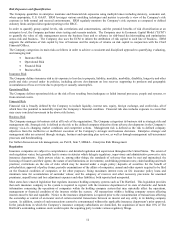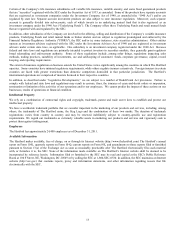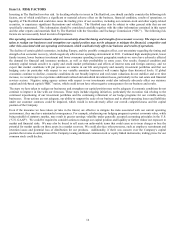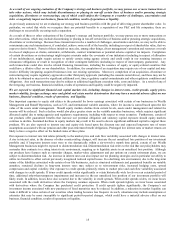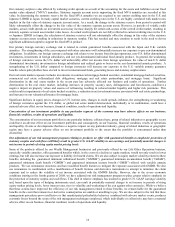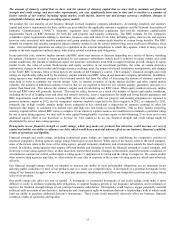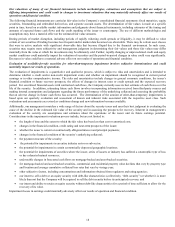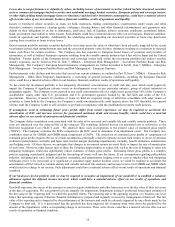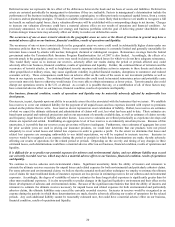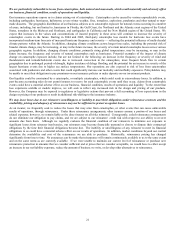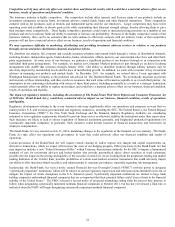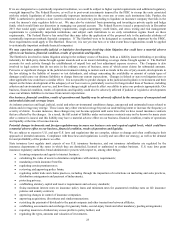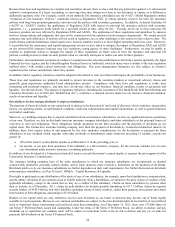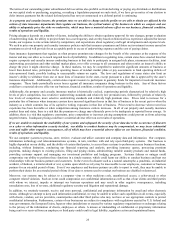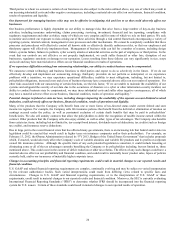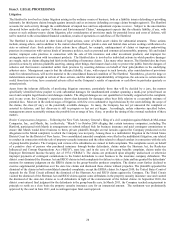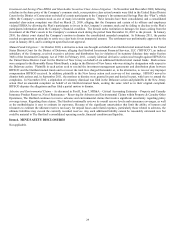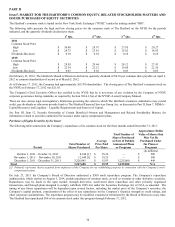The Hartford 2011 Annual Report Download - page 20
Download and view the complete annual report
Please find page 20 of the 2011 The Hartford annual report below. You can navigate through the pages in the report by either clicking on the pages listed below, or by using the keyword search tool below to find specific information within the annual report.20
Deferred income tax represents the tax effect of the differences between the book and tax basis of assets and liabilities. Deferred tax
assets are assessed periodically by management to determine if they are realizable. Factors in management’ s determination include the
performance of the business including the ability to generate capital gains, to offset previously recognized capital losses, from a variety
of sources and tax planning strategies. If based on available information, it is more likely than not that we are unable to recognize a full
tax benefit on realized capital losses, then a valuation allowance will be established with a corresponding charge to net income. Charges
to increase our valuation allowance could have a material adverse effect on our results of operations and financial condition. As
previously announced, we are evaluating our strategy and business portfolios with the goal of delivering greater shareholder value.
Certain strategic transactions may adversely affect our ability to realize our deferred tax assets.
The occurrence of one or more terrorist attacks in the geographic areas we serve or the threat of terrorism in general may have a
material adverse effect on our business, financial condition, results of operations and liquidity.
The occurrence of one or more terrorist attacks in the geographic areas we serve could result in substantially higher claims under our
insurance policies than we have anticipated. Private sector catastrophe reinsurance is extremely limited and generally unavailable for
terrorism losses caused by attacks with nuclear, biological, chemical or radiological weapons. Reinsurance coverage from the federal
government under the Terrorism Risk Insurance Program Reauthorization Act of 2007 is also limited. Accordingly, the effects of a
terrorist attack in the geographic areas we serve may result in claims and related losses for which we do not have adequate reinsurance.
This would likely cause us to increase our reserves, adversely affect our results during the period or periods affected and, could
adversely affect our business, financial condition, results of operations and liquidity. Further, the continued threat of terrorism and the
occurrence of terrorist attacks, as well as heightened security measures and military action in response to these threats and attacks or
other geopolitical or military crises, may cause significant volatility in global financial markets, disruptions to commerce and reduced
economic activity. These consequences could have an adverse effect on the value of the assets in our investment portfolio as well as
those in our separate accounts. The continued threat of terrorism also could result in increased reinsurance prices and potentially cause
us to retain more risk than we otherwise would retain if we were able to obtain reinsurance at lower prices. Terrorist attacks also could
disrupt our operations centers in the U.S. or abroad. As a result, it is possible that any, or a combination of all, of these factors may
have a material adverse effect on our business, financial condition, results of operations and liquidity.
Our business, financial condition, results of operations and liquidity may be materially adversely affected by unfavorable loss
development.
Our success, in part, depends upon our ability to accurately assess the risks associated with the businesses that we insure. We establish
loss reserves to cover our estimated liability for the payment of all unpaid losses and loss expenses incurred with respect to premiums
earned on the policies that we write. Loss reserves do not represent an exact calculation of liability. Rather, loss reserves are estimates
of what we expect the ultimate settlement and administration of claims will cost, less what has been paid to date. These estimates are
based upon actuarial and statistical projections and on our assessment of currently available data, as well as estimates of claims severity
and frequency, legal theories of liability and other factors. Loss reserve estimates are refined periodically as experience develops and
claims are reported and settled. Establishing an appropriate level of loss reserves is an inherently uncertain process. Because of this
uncertainty, it is possible that our reserves at any given time will prove inadequate. Furthermore, since estimates of aggregate loss costs
for prior accident years are used in pricing our insurance products, we could later determine that our products were not priced
adequately to cover actual losses and related loss expenses in order to generate a profit. To the extent we determine that losses and
related loss expenses are emerging unfavorably to our initial expectations, we will be required to increase reserves. Increases in
reserves would be recognized as an expense during the period or periods in which these determinations are made, thereby adversely
affecting our results of operations for the related period or periods. Depending on the severity and timing of any changes in these
estimated losses, such determinations could have a material adverse effect on our business, financial condition, results of operations and
liquidity.
It is difficult for us to predict our potential exposure for asbestos and environmental claims, and our ultimate liability may exceed
our currently recorded reserves, which may have a material adverse effect on our business, financial condition, results of operations
and liquidity.
We continue to receive asbestos and environmental claims. Significant uncertainty limits the ability of insurers and reinsurers to
estimate the ultimate reserves necessary for unpaid losses and related expenses for both environmental and particularly asbestos claims.
For some asbestos and environmental claims, we believe that the actuarial tools and other techniques we employ to estimate the ultimate
cost of claims for more traditional kinds of insurance exposure are less precise in estimating reserves for our asbestos and environmental
exposures. Accordingly, the degree of variability of reserve estimates for these longer-tailed exposures is significantly greater than for
other more traditional exposures. It is also not possible to predict changes in the legal and legislative environment and their effect on the
future development of asbestos and environmental claims. Because of the significant uncertainties that limit the ability of insurers and
reinsurers to estimate the ultimate reserves necessary for unpaid losses and related expenses for both environmental and particularly
asbestos claims, the ultimate liabilities may exceed the currently recorded reserves. Increases in reserves would be recognized as an
expense during the periods in which these determinations are made, thereby adversely affecting our results of operations for the related
periods. Any such additional liability cannot be reasonably estimated now, but could have a material adverse effect on our business,
financial condition, results of operations and liquidity.




